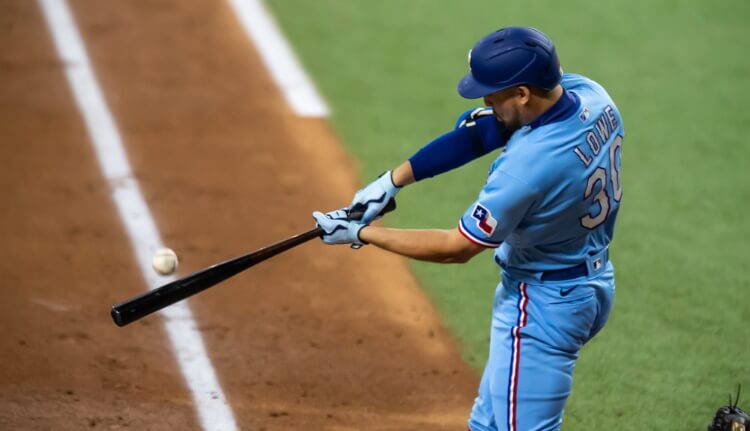“We cannot become what we want by remaining what we are.”
Baseball is a game that has consistently evolved. In fact, the only thing that remains constant is the need for change. With more rule changes, such as a pitch clock, ban of shifts, and automatic strike zone, on the horizon, this will only continue to be the case. There will always be adjustments that have to be made to stay ahead of the pack, and adaptability can be what separates the stars from everyone else.
To add to this, no baseball player, let alone human being, is perfect. What does that mean? There is always room for growth. It’s fun to practice what we’re good at, but simply minimizing our weaknesses can go a long way to achieving our ultimate goals. In baseball, when you’ve been able to get by on your raw abilities, this can be difficult to do. That being said, every player to make the major leagues has an extraordinary amount of talent, meaning that any sort of stubbornness can come back to bite you in a major way.
Okay, enough spiritual poetry here! After being an unheralded prospect early into his career, Nathaniel Lowe was able to work his way up the ranks to becoming the Rangers starting first baseman following his trade from Tampa Bay. So far, his raw abilities have been on full display, but is there more in the tank to become a perennial All-Star? That’s the million-dollar question we’ll be looking to answer. What makes Lowe so intriguing? Let’s dive into it!
Nathaniel Lowe: From Unknown To Offensive Star
Every MLB player gets to the show in a different way, and the Lowe family is a clear example of this.
Whereas younger brother Josh was a first-round pick by the Rays and a consistently hyped-up prospect, older brother Nathaniel had to wait until the 13th round to be drafted by the same team (now that’s a fun fact). While Josh was able to get drafted out of high school, Nathaniel had to take a different route. After not receiving any sort of significant playing time during his freshman year at Mercer, he then transferred to a junior college, performing well enough to receive a chance to play every day at Mississippi State.
From there, Lowe thrived, posting a .348/.423/.490 slash line while walking more than he struck out. Now, a .142 isolated power (ISO) isn’t what you’re looking for from a first baseman, but, at the same time, Lowe’s on-base ability couldn’t be denied. Likely due to the concerns about his power, sample size of production, and lack of defensive value, Lowe had to wait until the third day of the draft to be selected and didn’t appear to be on the radar for general prospect outlets. Initially, with just a .114 ISO during his first full minor-league season, those concerns seemed to be borne out. Not for long, though.
To start the 2018n season, the Rays sent Lowe back to High-A, where he was a force of nature with a 191 weighted-runs-created-plus (wRC+). Now, when players repeat a level, we can often see their production slightly inflated, but considering Lowe then went to Double-A and posted a 193 wRC+, and then reached Triple-A as a 22-year-old, that certainly wasn’t an applicable factor for him. All together, he was 78% above league-average (178 wRC+) across those three levels, showcasing the type of power (.239 ISO) we hadn’t seen from him previously. Talk about bursting onto the scene in a hurry! Cleary, this was enough for many to take notice, as the prospect gurus at Fangraphs pointed out in their 2019 report of him:
“The missing element here is that while Lowe had plus raw power the first time we saw him at Mississippi State, he didn’t have the kind of swing or approach to get the most out of it. This untapped tool and his plate discipline are the reasons he was a 13th rounder and not a 35th rounder who went back to school for his senior year. In 2018, Lowe did a rare thing: he tried to do more damage at the plate and lift the ball a bit more, but was able to keep his contact rates the same while adding game power. Miguel Andujar did this in the Yankees farm system two years in a row and went from an untapped, toolsy prospect who was passed over in the Rule 5 Draft to a Rookie of the Year runner-up; Lowe went from the top of the “Others of Note” section last year to one of the top 150 prospects in the game over a 12 month period. Lowe is a fine defender at first but the value here is all in the bat. Because he’s left-handed, the downside is a platoon option at 1B/DH, though the Rays cycle through those types very quickly. Underlying indicators and TrackMan data suggest Lowe’s very loud 2018 stats aren’t fluky and he may just be a 50 bat with advanced feel for the zone and 60 game power, which is a solid regular.”
Still, in a crowded Rays farm system featuring three players with the last name of Lowe (I promise I’m not making that up), it was easy for Nathaniel to slip under the radar, with Baseball America (97th) the only major prospect outlet to have him as a top-100 prospect. So, what did he do? He continued to hit, posting a 141 wRC+ in Triple-A before also performing at an above-average clip in 169 MLB plate appearances as well. Now, he only played a limited role in 2020, struggling with strikeouts (36.3% K), but he still posted a 103 wRC+, and this was only a 76 plate appearance sample.
Given Tampa Bay’s immense position player depth, particularly at first base/designated hitter, it was difficult for Lowe to find a clear role on their roster. Thus, they ended up trading him to the Rangers in a package including prospect Heriberto Hernandez, who at the time was gaining a tremendous amount of helium after an elite showing in Rookie Ball. To move on from such a promising prospect while in a rebuild shows how much Texas thought of Lowe’s ability to develop into a potent offensive contributor; they clearly envisioned him being a part of their next contending team. Perhaps most importantly, though, Lowe finally had his chance to shine.
Nathaniel Lowe: A Mixed Bag of a 2021 Season
Although the team wasn’t expected to be postseason contenders, the 2021 season was still a pivotal one for the Rangers. See, they were set to open up their new stadium in 2020, but due to the COVID-19 pandemic, 2021 was the first time their fans would be able to attend games there. Thus, even if they didn’t have a star-studded team, they needed a competitive team in order to take advantage of this “honeymoon window”.
Now, with a 60-102 record, third-worst in the MLB, that did not particularly happen. Certainly, though, this was not due to Lowe, whose 115 wRC+ was the second-highest on the team, first if you don’t include Joey Gallo, who was traded at the trade deadline. Now, in terms of his offensive runs above average (9.5), he was still just middle-of-the-pack (17th) amongst first basemen. That being said, there were a lot of encouraging signs.
From the beginning, Lowe’s calling card has been his on-base ability, and that held up in his first full season. Not only did he demonstrate clear contact ability, but he walked at an impressive 12.5% clip, leading to a healthy .357 on-base percentage. With a well-above-average 22.9% chase rate with neutral aggression in the zone (66.2%), giving him some of the best swing decisions in baseball. That’s quite the foundation to build upon, particularly since power has historically been found to be the one trait that develops the most over time.
That’s where the mixed bag with Lowe’s 2021 season really comes into play. See, his 113.9 max exit velocity put him in the top 9% of the league in terms of calculated raw power, while Fangraphs gave him a 65/80 raw power grade as recently as 2019. As you’d expect from someone listed at 6’4″, 220 pounds, the raw power is very clear, so why did Lowe muster just a .151 ISO and fail to hit 20 home runs in 642 plate appearances? This is where the connection between contact quality and contact trajectory comes into play.
When you’re hitting a ground ball in 54.5% of your batted balls, it certainly is going to be difficult for you to maximize your raw power, as we have seen from Eric Hosmer, Yandy Diaz, and many others. For Lowe, fastballs (56.8% GB), particularly sinkers (68% GB), did him in. Where specifically? With a flat bath path, pitchers could neutralize his power lower in the zone, as evidenced by his average launch angle by zone quadrant:
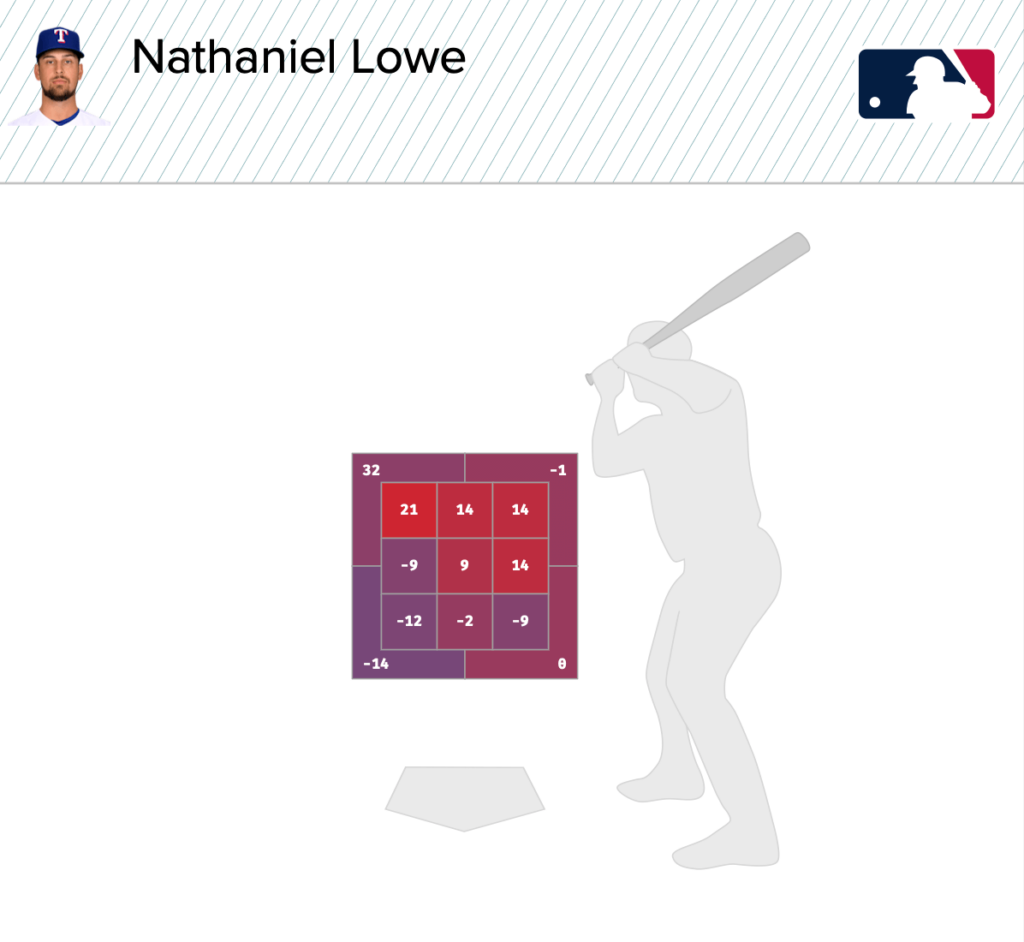
Throw a fastball, especially a sinker, low in the zone, and it’s very likely you can get Lowe to hit a worm burner. In fact, his lowest barrel rate (6.8%) came against fastballs, which pitchers clearly realized as the season went on:
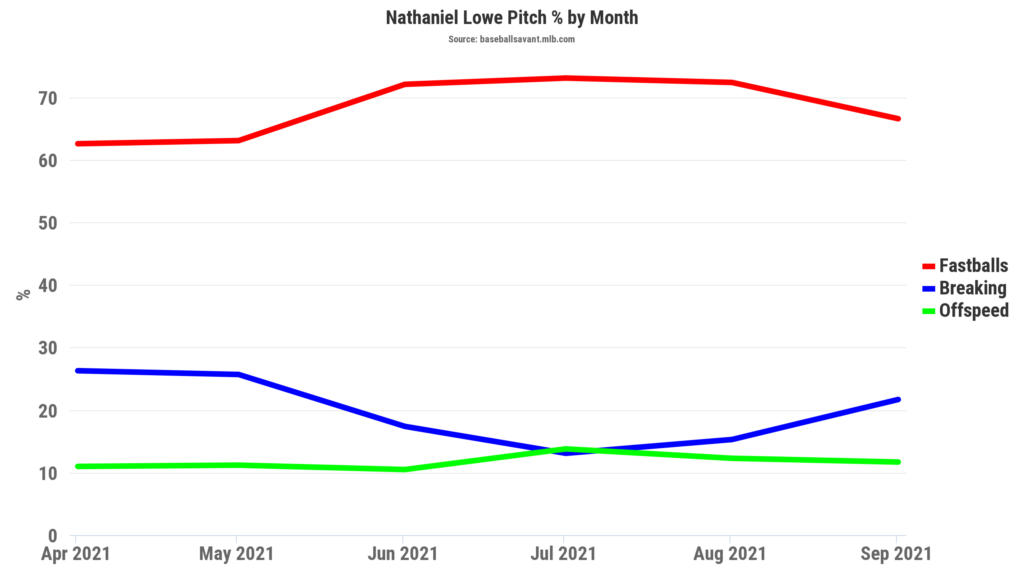
According to Fangraphs, no qualified hitter say more fastballs last season than Lowe, and for good reason. Unfortunately, this didn’t work out well, which fell off dramatically after the start of the season:
BARREL RATE BY MONTH
- April: 14.3%
- May: 10.8%
- From June on: 8%
It’s one thing to find success when immediately coming up to the majors, but as pitchers discover your weaknesses, they’re going to do everything in their power to exploit it. The vast amount of information within the game of baseball is astonishing, allowing pitchers to prep for opposing hitters like never before. Clearly, Lowe couldn’t quite adapt to how pitchers were attacking him, leading to a much higher quantity of ground balls.
Hitting the ball in the air is one way to get to as much raw power as possible. In many cases, though, nearly as important is pulling the ball. Pulled fly balls have historically performed much better than other fly balls, and it makes sense; it’s easiest to pull a ball for a greater distance, while you can take advantage of shorter dimensions. This is the Marcus Semien approach to hit for the optimal amount of power, though it isn’t something all hitters can achieve. Just take Lowe’s spray heat map from last year as a clear example.
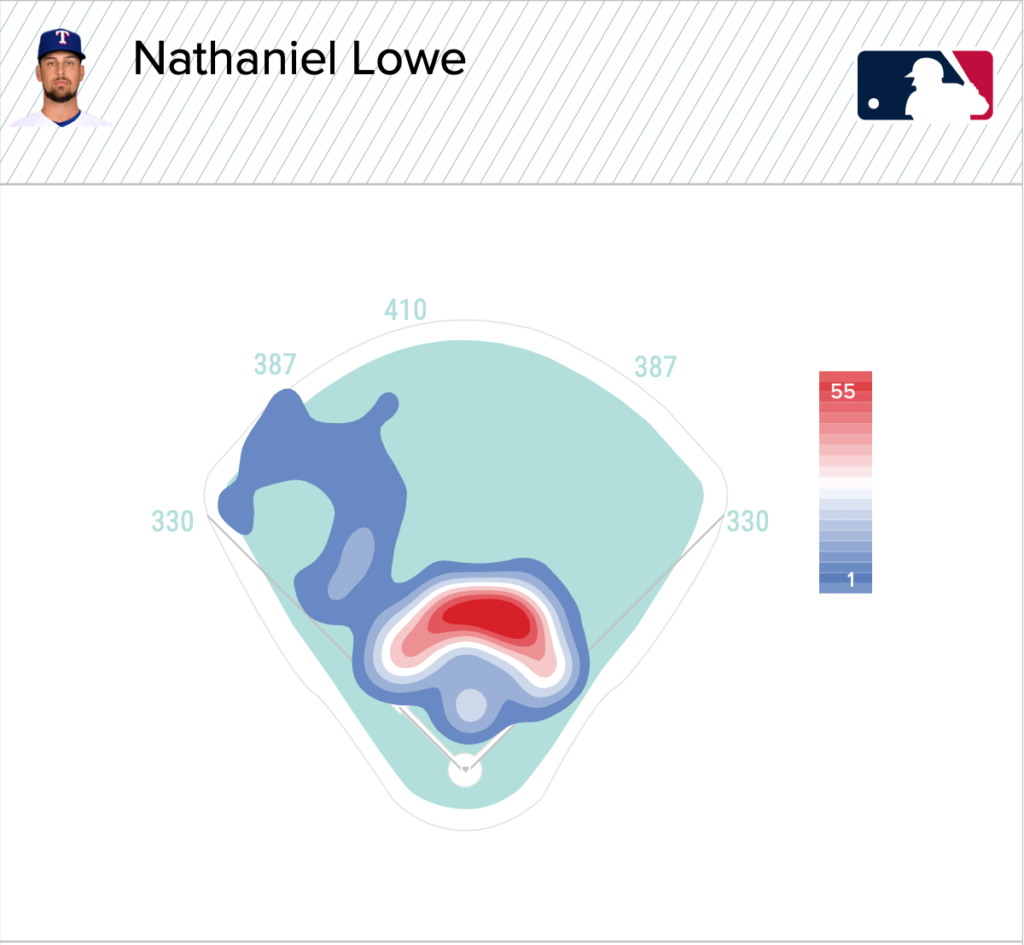
Lowe’s 24.9% pull rate was tied for second-lowest in all of baseball, associating him with the likes of DJ LeMahieu, Nicky Lopez, Myles Straw, and Ramiel Tapia. For those hitters, who specialize in making a lot of contact and hitting for a high average, this is the ideal approach. For Lowe, someone with as much measured power as he does, this is not the case. As you can see, not only was he hitting a lot of ground balls, but the few fly balls he did hit were going the other way, which is precisely how one doesn’t hit for as much power as one should.
Lowe’s swing decisions were tremendous, giving him a clear knack for getting on base. However, considering his raw abilities, the ceiling was much, much higher than the 115 wRC+ he posted last season. Could it all come to fruition this season? So far, there are plenty of positive signs, even if ultimate outlook is still quite perplexing.
A Promising (and Confusing) 2022
After being arguably the team’s best offensive performer last season, it’s safe to say Lowe was surrounded by a team with much more surrounding talent this season. That’s what happens when your team signs Corey Seager and Marcus Semien, trades for Mitch Garver, and also gets strong returns from Jonah Heim, Adolis Garcia, and Kole Calhoun. However, with the marquee free agents struggling, it’s been players like Lowe who have picked up the slack.
Now, things weren’t promising initially. Although Lowe had a 124 wRC+ through the first month of the season, that was being boosted by a very unsustainable .393 batting average on balls in play (BABIP). In fact, when you look at his .088 ISO 3.2% barrel rate, and 54.8% ground ball rate, there was a lot of reason to be concerned. Since then, though, things have changed:
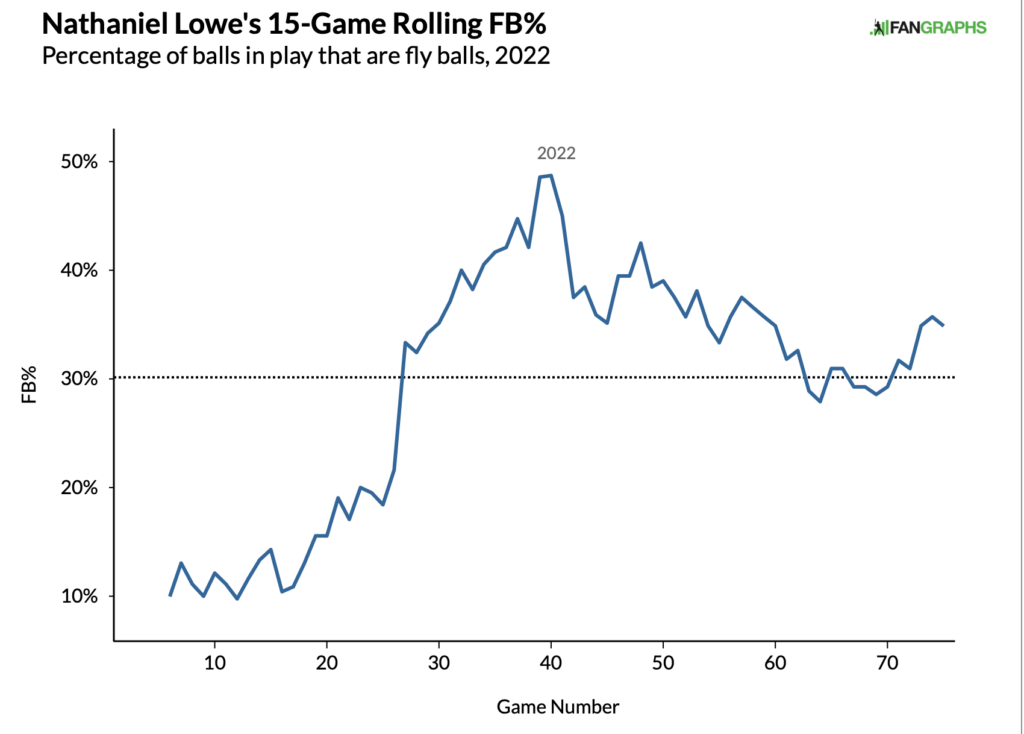
Considering the success he was having early on, it’s understandable that Lowe may have been hesitant to make a swing/approach change. Clearly, though, the presence of new offensive coordinator Donnie Ecker, who was credited with several of the major hitting success stories the Giants had last year, is appearing to have a positive influence on Lowe. Regardless of the reason, he’s hitting fly balls in a way we haven’t seen consistently before, which is remarkably encouraging.
With that in mind, it isn’t a surprise that Lowe boasts a strong 10.2% barrel rate since the start of May. Considering a considerable amount of his gains hitting the ball in the air have been with the fastball, this is very encouraging, to the point pitches are now attacking him higher with the fastball; his 2.97 feet average fastball vertical height in June was about 0.3 feet higher than it was in April. Add in the fact he’s even pulling the ball (30.6%) slightly more, and there are a lot of reasons to be optimistic.
See, in addition to hitting more balls in the air, Lowe has also demonstrated a much more aggressive approach increasing his chase rate (29%) and zone-swing rate (73.7%) by about seven points each. Consequently, he is walking (7.3%) less than ever, which is negatively impacting his on-base ability. Ultimately, the goal would be for Lowe to be able to mesh added power with the foundation of on-base skills, but, right now, it would appear he’s compensating for his struggles in one area by cutting away from his strengths.
Fortunately, there are signs of that changing:
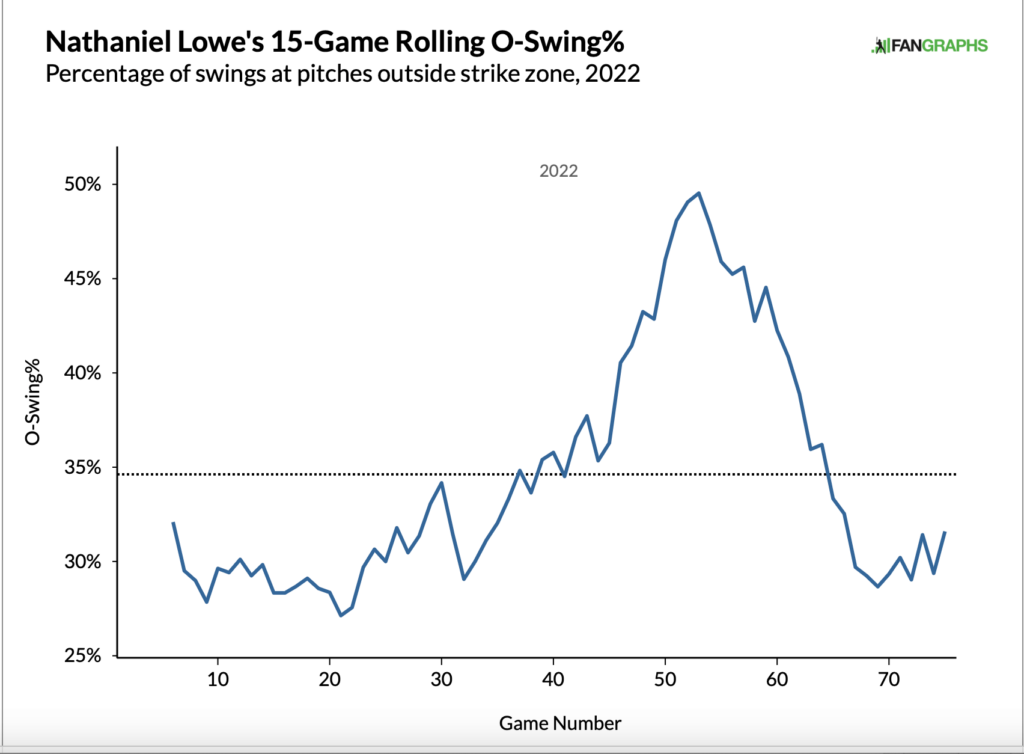
Can we see this trend continue, thus balancing Lowe’s on-base skills with a power breakout? That is the hope. ZiPs projects Lowe to post a .270/.351/.447 slash line with a 129 wRC+, which is well within the range of outcomes. If so, I’m sure all parties would be quite thrilled with that outcome. In spite of the low walk rate, he’s still mustering a 128 wRC+; although projections are split on him, there are plenty of reasons to expect him to reach his high range of outcomes.
Overview
Baseball is a hard game on its own. Now, add in trying to make adjustments on the fly, and the degree of difficulty skyrockets.
At the same time, as is the case with all aspects of life, change is often necessary. For Nathaniel Lowe, the journey has been rocky, but since the beginning, the foundational skills have always been there. After all, any hitter who can make strong swing decisions, get on base, and hit the ball extremely hard should always garner your attention.
This has been the driving force for Lowe all along, but, now it’s time for his untapped upside to be realized. After struggling to lift and pull the ball last season, he’s showing serious signs of progress this year, while also stabilizing some of his early plate discipline warts. When it is all said and done, we could easily be looking at one of the more complete offensive first basemen, or at least a hitter 25-30% above league average. That’s quite valuable, and something that we should not gloss over.
Now, we just have to wait to see how the rest of the season turns out for Lowe. Right now, though, we should be extremely optimistic about the first baseman’s outlook moving forward. The transition to becoming the player he has the potential to be may not be “Lowe hanging fruit”, but change is happening! When it’s all said and done, the Rangers could have themselves quite a potent lineup in a few years.

